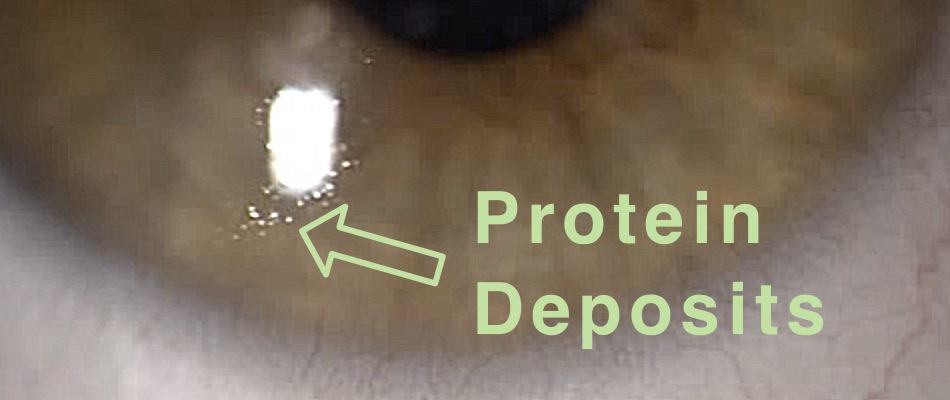Protein deposits are an issue for a lot of contact lens wearers. After reading this article you will know what causes protein deposits how you could prevent them and how to get rid of them.
When soft contact lenses are positioned on your eye they are surrounded by the tear film which consists of proteins, mucin, water, electrolytes, and lipids. Depending on the quality and quantity of your tear film in combination with the contact lens material you wear components like proteins accumulate easier on the contact lens surface.
When protein deposits start to accumulate on the lens surface lens loses the smooth feel but starts to feel dull. As you look closely at the lens or under a microscope like in the video below you can see semi-transparent little dots can be seen on the surface. A lot of them turn white or grey when you shine a light on the deposits.
One way to get rid of the lenses is to use a protein cleaner. Most of those cleaners should be used once a week and are available as drops or as tabs working in a solution to clean the protein deposits on your contact lenses. With hard RGP lenses, you could switch to an abrasive cleaner. This intensifies the mechanical rubbing between your fingers which should be done daily for at least 30 seconds.
One word of caution though. A switch-in with contact lens care products should be always communicated to your contact lens specialist as some of the contact lenses have coatings on them which would be destroyed with abrasive cleaners. Depending on the contact lens the surface of the lens could also be polished by your optician to get rid of the protein deposits.
What Causes Protein Deposits on Contacts?
The spongy build of soft contact lenses is more prone to accumulate little molecules like lysozyme on the lens surface. It can also happen with RGP lenses but usually, the small molecular structure in combination with its positively charged state easily deposits on negatively charged substrates with a high water content like soft contacts. Lysozyme makes up to 40% of total tear proteins.
Why Could They Be Problematic?
Despite the temporary loss in visual acuity, worse wetting characteristics, and more foreign body there is a major problem with protein deposits on your contact lenses. There are denatured proteins that increase the likelihood of clinical symptoms like allergic reactions associated with protein deposits on contact lenses. The factors impacting protein denaturation are:
- Lens care solutions
- Lens age
- UV light
- Temperature
This deposits with denatured proteins could even trigger an immunological response that could result in contact lens papillary conjunctivitis (CLPC).
How Do You Prevent Protein Deposits on Contacts?
The easiest way to prevent protein deposits from accumulating on your lens is to not give the proteins time to buildup deposits. That could mean increasing the frequency of using special cleaners like miraflow (which can be temporarily unavailabe) that do not disinfect the lenses but also really get rid of the protein deposits. Because not every lens cleaning solution does this.
As I said in the paragraphs above you could decrease the time the contact lens spends on your eye. Ideal here are daily contact lenses. Even when you wear them for long hours and they accumulate deposits on the lens surface after on the next day you start again with a fresh lens.
In comparison, bi-weekly or monthly contact lenses often can feel different and not as good as when you first put them on your eyes. This is because the contact lens material changes over time. And one of the causes for this loss in wearing comfort is the buildup of protein deposits that change the lens surface.

It is recommended to rub your lenses daily to prevent the deposits from accumulating on the lens surface. This should be done between your fingers for at least 30seconds in combination with saline.
How To Remove Protein Deposits From Contact Lenses?
Depending on how much deposits buildup on the contact lens surface different methods should be used to remove the protein deposits. When the contact lens shows low to medium protein deposits you can use the following:
- Tabs like (Amo Ultrazyme Enzyme & Avizor Enzyme) for soft contacts
- Progent for RGP lenses
- Boston advance for RGP lenses
But before you just buy those protein cleaners make sure your lens or the coating is compatible with it. For example, progent will lead to a quick breakdown of the Hydra PEG coating. And the Boston Advance cleaning solution will damage a lot of Menicon lenses. The coating on a lot of the lenses silly is not made for abrasive cleaners. But the mentioned cleaners only remove medium to low amounts of debris you have on the contact lens surface.
What if you need to clean contact lenses that have a lot of protein deposits on them. Well, there is not much you can do but put a lot of stress on the material to remove the deposits. One way to try is to use put the contacts in a solution based on 10% hydrogen peroxide. In combination with heat, the lens material swells. This process leads to unstick the deposits from the lens material.
This method is very effective to remove protein deposits. Unfortunately, the contact lenses could be damaged. despite changed wetting characteristics the shape of the contact lens could change as its color. The peroxide in such content could lead the contact lenses to turn pink a little.
As you can see it is better to not have deposits buildup and to get rid of them on a weekly basis. This ensures less risk to a loss in wearing comfort or even an allergic reaction. I hope you found the information on what protein deposits are and how to get rid of them.
I wish you a great day.
